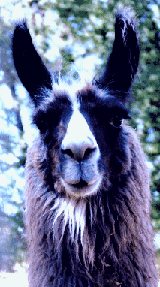Llama care, management and resources
- Llama FAQ
- Llama literature
- Basic care
- Castration
- Spaying
- About breeding llamas
- Handling young llamas
- Misdirected territorial aggression
- How old should llamas be for training and work?
Fiber from llamas
Llamas
as guardians
Classic performance llamas
Communicating
Our llama family
Just for fun
Cria photos
Training consultation
Performance
llama analysis
If you don't rescue ... DON'T BREED!

KB's story
KB began life as a normal, unhandled male weanling. He was fascinated by humans, but according to the practices of the day, was discouraged from interacting. After weaning, he went to a new home with some enthusiastic new llama owners (who, like many new owners at the time, went straight into making more llamas despite inexperience). KB was cute, grey, and woolly, so it was not surprising that he was kept intact for breeding.
When KB was bred at the rather immature age of 18 months, his personality seemed to change -- he tried to mount his handler the next day. Because KB's breeder told the worried owners that some of his relatives had required rehab, suddenly his threatening posture at feeding time took on a whole new light. The owners did what was recommended to llamas that threaten people, and in a short time, KB's behavior had deteriorated badly. Soon he was on his way here for rehab.
Having been told that we would be dealing with a known aggressive llama (and having worked with one very aggressive half-brother), we immediately structured the situation to put KB on the defensive. We didn't want him to get the upper hand. However, within a week, it became apparent that what we had been told bore little resemblance to what was actually going on -- KB was one frightened llama who really had no desire to harm anyone.
KB also had hair-trigger emotions -- and no big surprise to us why when we finally saw his pedigree. Usually the emotion was fear, and once we knew what really bothered him, we were able to work on his rehab without setting off the sort of emotional reactions that would shut down his brain and any chance for learning along with it. However, another complication arose -- one of KB's owners died, and the other didn't want to keep llamas anymore.
We placed KB for the estate with what appeared to be a very suitable home, and gelded him at the new owner's request. We provided the experienced owner with a full written disclosure of KB's history and our recommendations for encouraging continued good behavior. Several months later, we found that KB had been quickly traded off to another party, without any mention of his rehab (let alone any paperwork). It just so happened that KB hated this individual, and his completely new repertoire of bad behavior was about to earn him a ticket to a "horse trader" style llama buyer who intended to palm KB, his dense wool, and his defectively conformed body off on some unsuspecting sucker as a pack llama.
KB had just become a candidate for rescue.
When Gwen picked KB up, she was regaled with tale after nasty tale of deliberate spitting, screaming, and more. KB, however, haltered easily for Gwen without any fuss, and happily leapt into the stock rack on the truck. Back at home, we turned KB out in the pasture, thinking he would be just fine. But the next time Gwen had occasion to catch him, KB screamed pitifully helpless screams, trembled and spat defensively. KB was more than a rescue -- now he needed abuse rehab.
It took some time to uncover all of KB's new fears. Most revolved around grooming -- KB had been subjected to a useless fashionable "poodle cut," and other questionable show grooming practices that we'd always suspected were very painful for woolly llamas. However, with time as a healing partner, KB recovered enough to be placed again -- this time under our own contract and protective clauses.
KB and a female lama friend have now lived with a first-time llama owner since 1994. KB had one incidence of stress-spitting over food he feared would be removed, but has otherwise been living a relaxing and uneventful life (except for chasing loose dogs, which he enjoys). KB won't ever be expected to go to shows, and his fine, dense wool is shorn and used for handspinning instead of being teased and pulled: A happy ending despite a very rocky start.
Return to Llama
Rescue and Rehabilitation
Return to Lost Creek Llamas home page